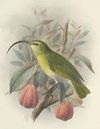Genus Hemignathus
Greater Akialoa - The Oʻahu ʻAkialoa was a species of finch in the Fringillidae family. The Oʻahu ʻAkialoa was a species of Akialoa, or long-billed insectivorous bird that was that was found in the high elevation forest. It was a dull colored species, dull green on the belly, bright green on tail on rump and tail, dark olive-grey back and speckled yellow and green on the head. It was endangered from the loss of habitat; it was very prone to Avian Flu, a disease that was introduced by the mosquito. This bird was mainly an insectivore using its bill to probe through the bark in search of bugs to eats. It also used its long bill to go into flowers to reach their stores of nectar. When the forests are cleared the bird could not find any food, as a result, they would starve. The birds were also weak against the natural diminishing factors like weather and competition from other native nectar feeding birds. Scientists were sure that this bird was still common in the 1860’s, evidence found by Perkins. Afterward, few reports came in,
Oahu Amakihi - This species was first named by Andrew Bloxam . He saw it and collected specimens from Oʻahu while in the Hawaiian Islands in 1825 as the naturalist on board HMS Blonde.
Kauai Amakihi - The Kauaʻi ʻAmakihi is the species of ʻAmakihi that is found on Kauaʻi. It was created when the original Amakihi spread across the islands as they migrated. These birds eventually stopped moving and adapted with the islands. Each form of the ʻAmakihi is slightly different from the others from color, song, and habitat. The Kauaʻi ʻAmakihi is a common green bird that appears to have some resistance to the diseases. It has been confused as a greener form of the ʻAnianiau. It is slightly larger, about five inches long. It has a dark eye stripe that goes down to the bill which is also black.
Hemignathus lucidus - Males have yellow underparts and head. The upperparts are duller, darker and greenish. Females are overall duller, with most of the underparts whitish. The lores, eye-ring and long decurved bill are blackish. It is 5.5 inches long.
Akiapolaau - The ʻAkiapōlāʻau is a species of finch in the Hawaiian honeycreeper subfamily, Drepanididae, that is endemic to the island of Hawaii. Its natural habitats are dry and montane moist forests, and the only bird species on the island to occupy the woodpecker niche.
Lesser Akialoa - The Hawaiʻi ʻAkialoa was a species of finch in the Fringillidae family. It was endemic to Hawaii. It became extinct due to habitat loss. It is also commonly called Lesser Akialoa, but this name dates back to the time when all small ʻakialoas were united in this taxon. The Hawaii Akialoa is the other species of bird on Hawai’i to disappear during this time period. It disappeared at around the same time as its Oahu cousin. It was a yellowish bird with a long two inch long, thin whitish-yellow bill. It had small olive green wings which it used to flit from tree to tree to look for insects like beatles and caterpillars. It was seen gleaning the trees in search of insects. The bill of the Akialoa was also designed for more than bug extraction. The Akialoa also fed on nectar in the flowers of lobelias and O’hia blossoms. Its long bill could easily fit into petals of long flowers and took pollen from flower to flower on its forehead. It was collected at several places. It was once thought to be the same species as t
Anianiau - Species: Himatione parva Stejneger, 1887 Magumma parva Viridonia parva
Hemignathus sagittirostris - The Greater 'Amakihi was a species of finch in the Fringillidae family. The Greater Amakihi was the largest recent Amakihi. It was brownish winged bird with a yellow body ending with a notched tail, and a whitish pointed beak. It was six inches long and it had blackish brown legs. The major difference between it and its relative was that its bill was white and the fact that the bird was six inches in comparison to the four inch Hawaiian Amakihi. It lived in a small tract of forest where it crept through the vines and trees for insects as part of its diet. It was thought to have been seen sipping nectar from O’hia trees. It was thought to have gone extinct when the only population was killed when the land they lived on was turned into a sugar plantation. After the land around Hilo was cleared in 1901, the bird was never spotted again. The ironic thing was that all large scale plantations like the one that was made on the Greater Amakihi’s land was abandoned. It appears not to have been widespread, found rarely
Kauai Amakihi - The Common ʻAmakihi or Hawaiʻi ʻAmakihi is a species of finch in the Hawaiian honeycreeper subfamily, Drepanididae. It is endemic to the main Hawaiian Islands except for Lanai, where it has been extirpated. It is one of the most common honeycreepers, inhabiting all types of habitat on the islands at elevations from sea level to 8,000 feet . Of all the forest birds native to Hawaii, the Common ʻAmakihi has been affected the least by habitat changes, and can even be seen in suburban Oahu. It is suspected that it is evolving resistance to diseases such as avian malaria. The Common ʻAmakihi is a small bird, measuring about 4 inches in length. It is a yellow-green bird with a small black bill that is 0.5 inches long and has brown eyes with black pupils.


